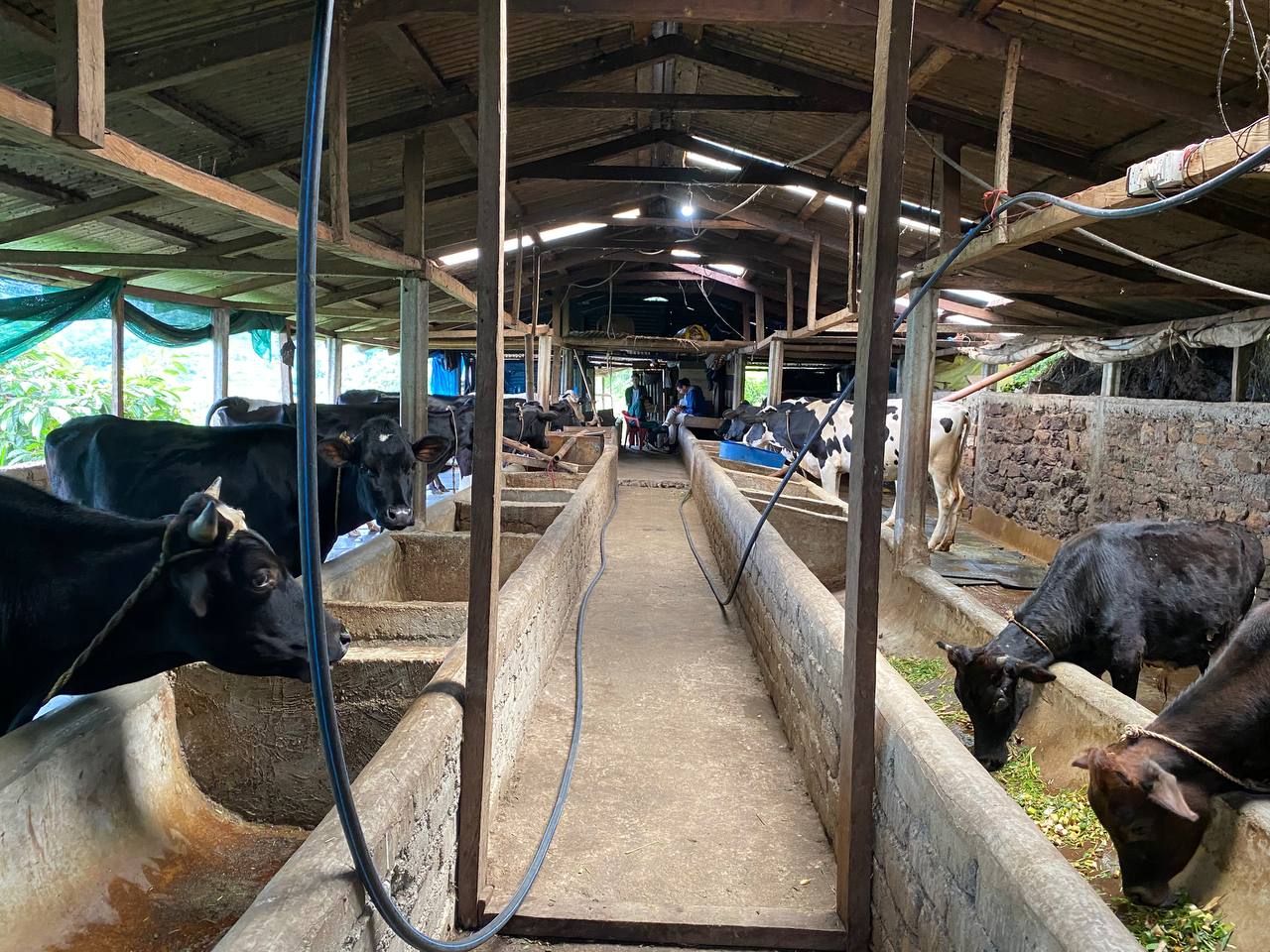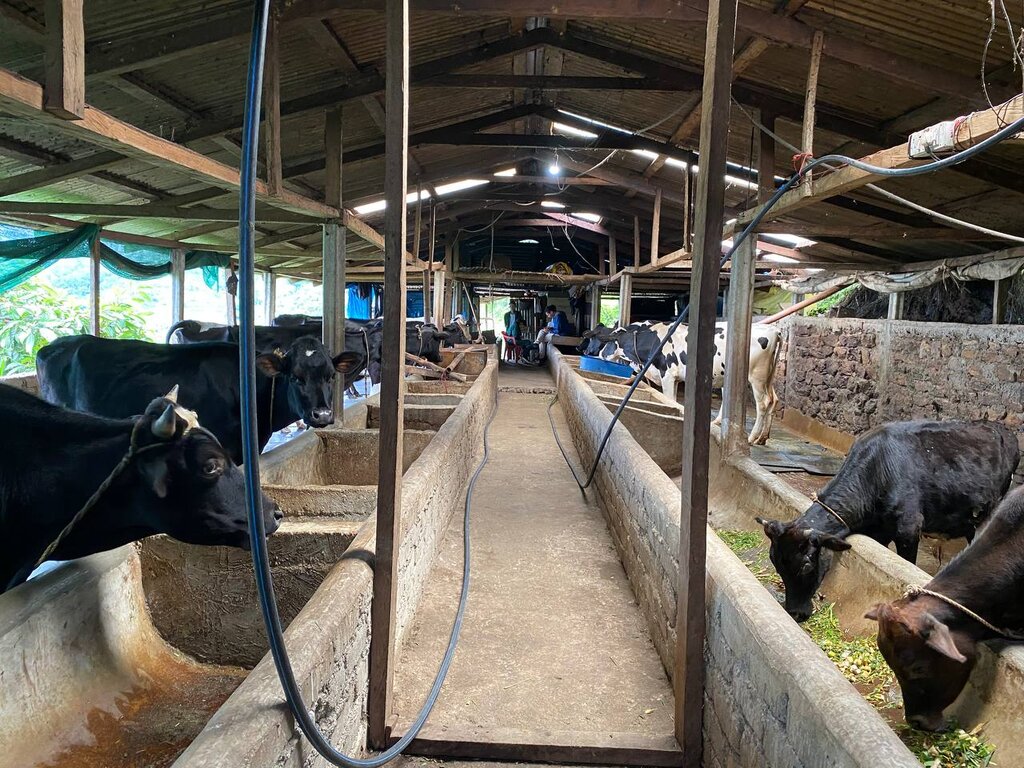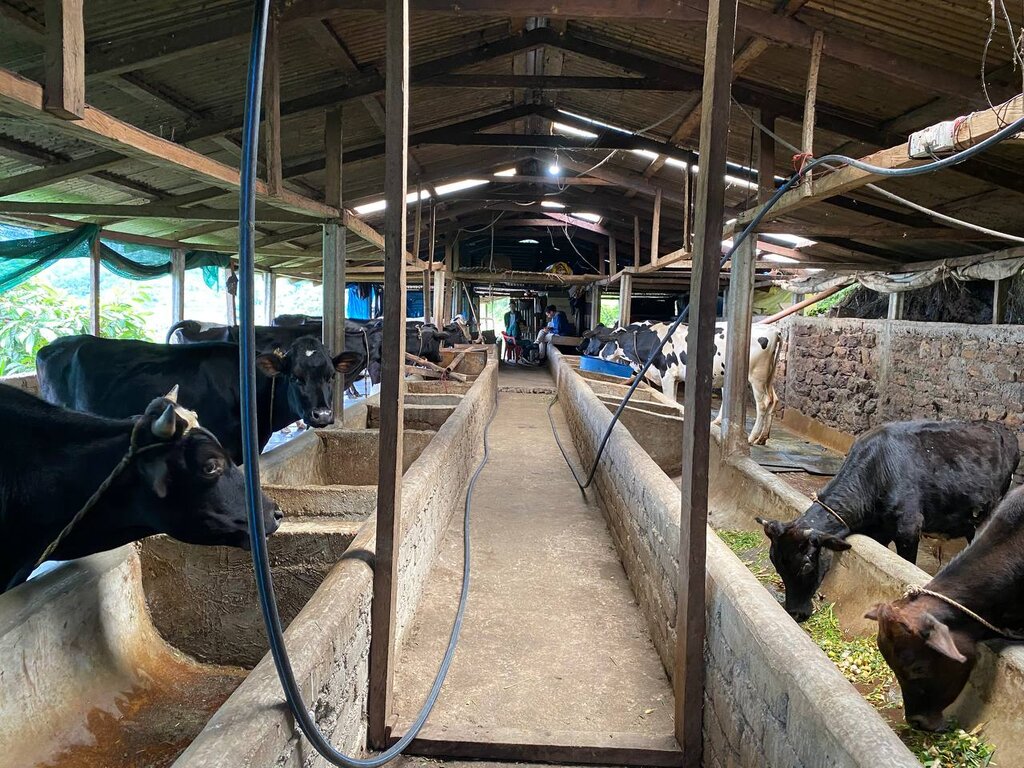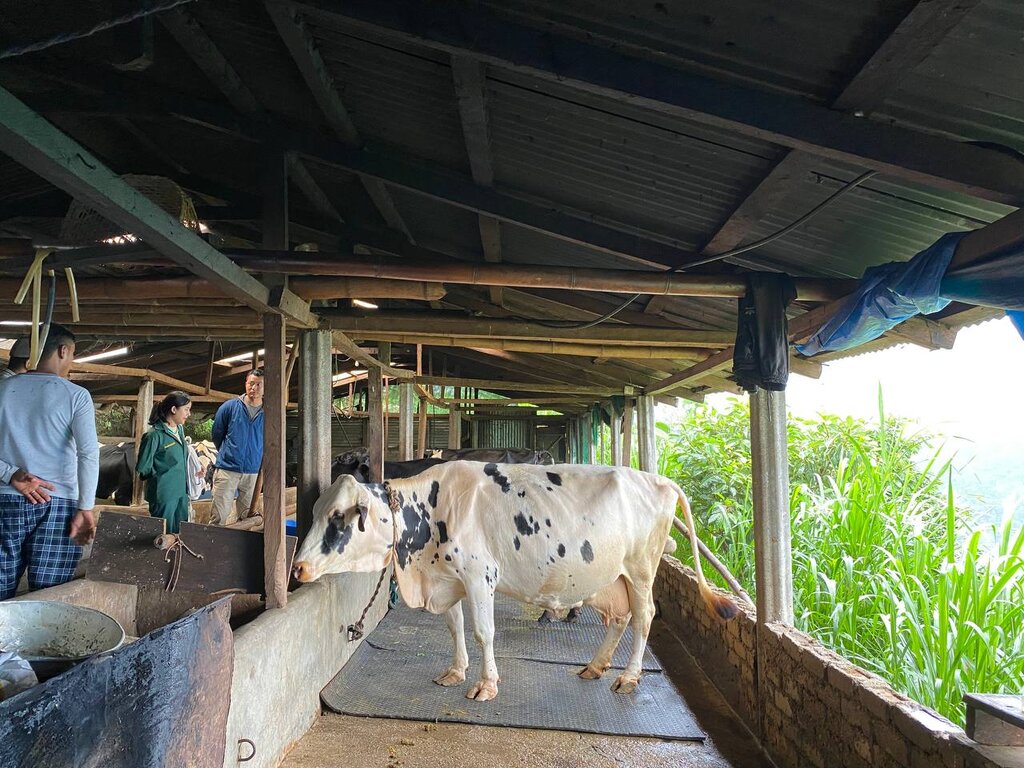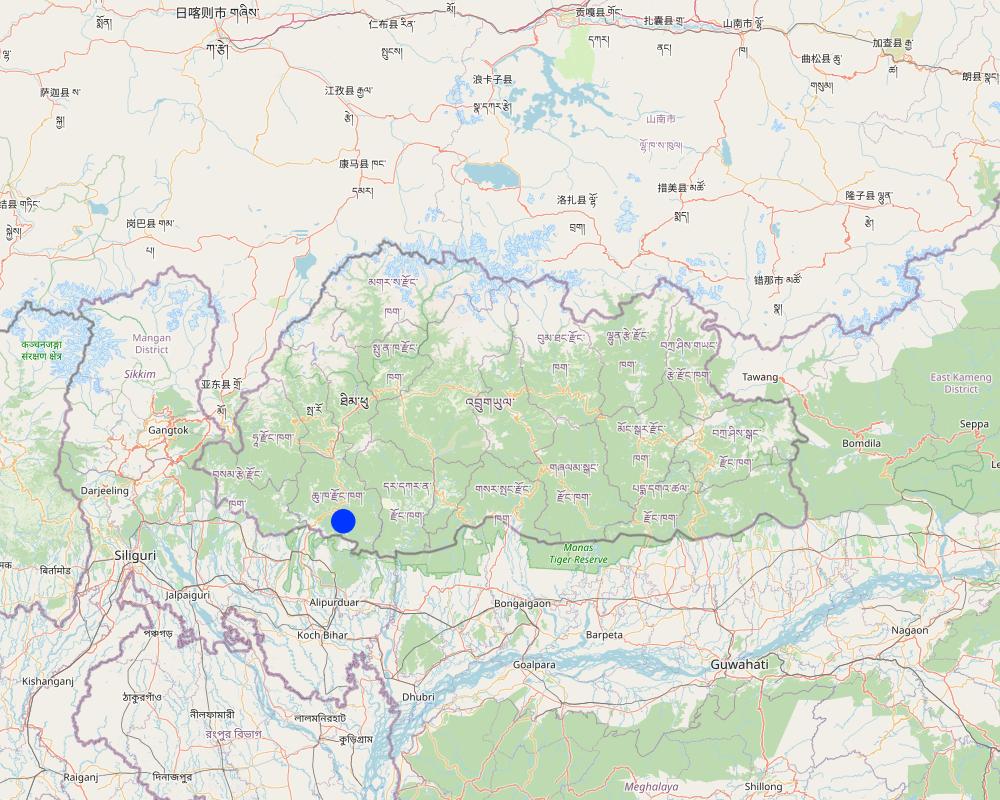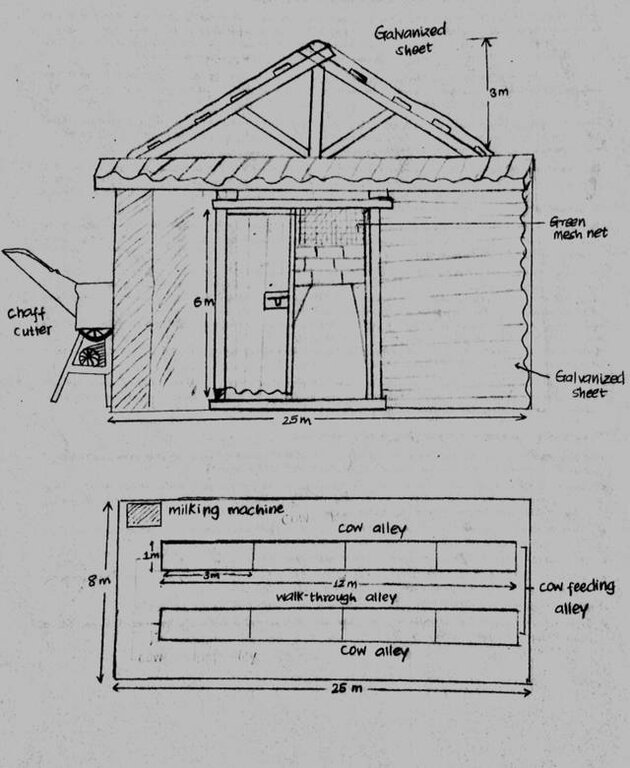Stall-Feeding of Dairy Cows [不丹]
- 创建:
- 更新:
- 编制者: Karma Wangdi
- 编辑者: Tashi Wangdi
- 审查者: William Critchley, Rima Mekdaschi Studer, Joana Eichenberger
Tsa Chhag Jin Tey Nor So Chong (རྩ་ཆག་བྱིན་སྟེ་ནོར་གསོ་སྐྱོང་།)
technologies_6869 - 不丹
查看章节
全部展开 全部收起1. 一般信息
1.2 参与该技术评估和文件编制的资源人员和机构的联系方式
关键资源人
土地使用者:
Chettri Hemlal
Arekha, Darla Gewog (Block), Chhukha Dzongkag (District)
不丹
有助于对技术进行记录/评估的项目名称(如相关)
Strengthening national-level institutional and professional capacities of country Parties towards enhanced UNCCD monitoring and reporting – GEF 7 EA Umbrella II (GEF 7 UNCCD Enabling Activities_Umbrella II)1.3 关于使用通过WOCAT记录的数据的条件
编制者和关键资源人员接受有关使用通过WOCAT记录数据的条件。:
是
1.4 所述技术的可持续性声明
这里所描述的技术在土地退化方面是否存在问题,导致无法被认为是一种可持续的土地管理技术?:
否
注释:
This technology does not have any problem with regard to land degradation
2. SLM技术的说明
2.1 技术简介
技术定义:
Stall-feeding is an improved cattle production system, which is increasingly being adopted with a growing population of high yielding exotic dairy breeds. Thus, most improved dairy cattle in Nepal are being reared under confinement with limited access to grazing, as it allows for easy and optimal supplementation of fodder.
2.2 技术的详细说明
说明:
Stall-feeding, or “zero-grazing”, is a livestock management approach that confines animals within stalls or pens for feeding. It offers various advantages, such as improved waste management, precise nutrition control, and reduced risk of overgrazing. It allows farmers to carefully regulate their animals' diets to ensure they receive the necessary nutrition for optimal growth and productivity (Hadush, 2002). To effectively implement stall-feeding, several key components are required. Firstly, animals must be housed in separate stalls of appropriate size to facilitate cleaning and waste collection. Secondly, a well-planned feeding system is essential, which may involve the use of automatic feeding equipment, or alternatively manual distribution of hay, grains, and supplements tailored to each breed’s unique nutritional needs. Thirdly, a comprehensive waste management system is crucial to handle the manure produced by confined animals, which involves thorough stall cleaning and composting, transforming waste into organic fertilizer. Proper water supply and ventilation are also imperative for the animals' health and well-being. Adhering to these technical requirements (Garber, 2010) ensures optimal productivity and animal welfare in the stall-feeding system.
Stall-feeding is employed in various agricultural contexts worldwide, particularly where traditional open grazing is impractical or unsustainable. It is applied in areas with limited grazing land and high population density, such as urban and peri-urban settings. Moreover, it may be used in arid or semi-arid regions with scarce natural pastures, as well as during dry seasons when grazing resources are scarce. Smallholder farms and intensive livestock production systems aim to maximize output while optimizing resource usage, making stall feeding a prevalent practice. Dairy farming employs stall-feeding to boost milk production and enhance the quality of dairy products (Oosting et al., 2021).
According to Sahoo et al. (2015), the primary objective of stall-feeding is to provide controlled and ideal conditions for managing and feeding cattle. This approach ensures that animals are housed indoors according to their age, sex, breed, and weight, preventing them from grazing outdoors. To establish a well-functioning system, several crucial steps must be taken. First and foremost is the construction of individual stalls or pens, with careful consideration of size and design to accommodate different animals comfortably. The implementation of a reliable and well-planned feeding strategy is equally crucial. Adequate water supply and optimal ventilation within the stalls are also vital considerations (Van Eerdenburg & Ruud, 2021).
One of the primary advantages of stall feeding is its ability to provide animals with controlled and balanced nutrition, resulting in improved growth rates and higher-quality products like milk or meat. It also aids in disease prevention and mitigates the environmental impact of overgrazing. However, the main drawback lies in the additional effort and expense associated with feeding, cleaning, and waste management. Improperly managed confinement can limit animals' freedom of movement, potentially affecting their behavioral and psychological well-being. Proper ventilation and hygiene within the stalls are essential to address these concerns (Sahoo et al., 2015).
The type of fodder grown for dairy cattle primarily includes a variety of grasses and legumes suitable for the region's climate and terrain. Common fodder crops grown for dairy farming include Napier grass (Pennisetum purpureum), Rhodes grass (Chloris gayana), Alfalfa (Medicago sativa), Clover (Trifolium spp.), Ryegrass (Lolium spp.) sorghum (Sorghum bicolor). Additionally, Bhutan's traditional agroecological practices may also involve grazing on natural pastures and feeding on crop residues such as maize stalks and rice straw.
In Bhutan, traditional cattle breeds such as the Jersey, Brown Swiss, and local breeds are commonly raised for milk production. The milk yield per cow varies significantly based on factors such as breed genetics, nutrition, health, and management practices. On average, dairy cows in Bhutan may produce anywhere from 5 to 10 liters of milk per day, although some high-yielding breeds or well-managed farms may achieve higher yields. However, it's essential to note that these figures are approximate and can vary widely.
2.3 技术照片
2.5 已应用该技术的、本评估所涵盖的国家/地区/地点
国家:
不丹
区域/州/省:
Chukha
有关地点的进一步说明:
Arekha, Darla,
具体说明该技术的分布:
- 适用于特定场所/集中在较小区域
技术现场是否位于永久保护区?:
否
注释:
n/a
Map
×2.6 实施日期
注明实施年份:
2016
如果不知道确切的年份,请说明大概的日期:
- 不到10年前(最近)
2.7 技术介绍
详细说明该技术是如何引入的:
- 通过土地使用者的创新
- 通过项目/外部干预
注释(项目类型等):
Stall-feeding technology was adopted for rearing Holstein Fresian cattle, with fund (low interest loan) supports from Rural Enterprise Development Corporation Limited/Cottage and Small Industry
3. SLM技术的分类
3.1 该技术的主要目的
- 改良生产
- 减少、预防、恢复土地退化
- 降低灾害风险
- 创造有益的经济影响
3.2 应用该技术的当前土地利用类型

牧场
集约放牧/饲料生产:
- 收割和携带/零放牧
动物类型:
- 牛 - 奶制品
是否实行作物与牲畜的综合管理?:
否
产品和服务:
- manure as fertilizer/ energy production
品种:
牛 - 奶制品
计数:
18
3.3 由于技术的实施,土地使用是否发生了变化?
由于技术的实施,土地使用是否发生了变化?:
- 是(请在技术实施前填写以下有关土地利用的问题)
同一土地单元内混合使用的土地::
否

牧场
粗放式放牧:
- 半游牧畜牧业
- 经营牧场
动物类型:
- 牛 - 奶制品
是否实行作物与牲畜的综合管理?:
是
如果是,请具体说明:
Grows fodder
产品和服务:
- manure as fertilizer/ energy production
品种:
牛 - 奶制品
计数:
18
注释:
16 Holstein Friesian and 2 Jersey cattle
3.4 供水
该技术所应用土地的供水:
- 混合雨水灌溉
注释:
The farm has independent water source.
3.5 该技术所属的SLM组
- 农畜综合管理
- 改良植物品种/动物品种
- 节能技术
3.6 包含该技术的可持续土地管理措施

结构措施
- S9:动植物庇护所

管理措施
- M1:改变土地使用类型
- M2:改变管理/强度级别
- M3:根据自然和人文环境进行布局
3.7 该技术强调的主要土地退化类型

土壤水蚀
- Wm:块体运动/滑坡

生物性退化
- Bc:植被覆盖的减少
注释:
He grows fodder nearby his dairy farm increasing the vegetation.
3.8 防止、减少或恢复土地退化
具体数量名该技术与土地退化有关的目标:
- 防止土地退化
4. 技术规范、实施活动、投入和成本
4.1 该技术的技术图纸
4.2 有关投入和成本计算的一般信息
具体说明成本和投入是如何计算的:
- 每个技术单元
指定单位:
Stall-feed unit
指定单位面积(如相关):
approx 3500 metres squared (Stall-Feeding unit)
其它/国家货币(具体说明):
Ngultrum
如相关,注明美元与当地货币的汇率(例如1美元=79.9巴西雷亚尔):1美元=:
80.0
注明雇用劳工的每日平均工资成本:
500
4.3 技术建立活动
| 活动 | 时间(季度) | |
|---|---|---|
| 1. | Site selection (Near the road) | Winter |
| 2. | Gathered raw materials | winter |
| 3. | Construction of shelter | winter |
| 4. | Construction of individual stalls with proper size and design to comfortably accommodate the cattles | winter |
| 5. | Set up a dependable and well thought feeding strategy | winter |
| 6. | Roofing of the stalls with CGI sheets | winter |
| 7. | Installation of proper ventilation for cattles | winter |
| 8. | Installing of water pumps to clean the areas | winter |
| 9. | Installing of miliking machine and chaff cutter | winter |
注释:
The dairy shed was constructed in April, 2016
4.4 技术建立所需要的费用和投入
| 对投入进行具体说明 | 单位 | 数量 | 单位成本 | 每项投入的总成本 | 土地使用者承担的成本% | |
|---|---|---|---|---|---|---|
| 劳动力 | labor | per head | 150.0 | 500.0 | 75000.0 | 100.0 |
| 设备 | Spade | numbers | 10.0 | 300.0 | 3000.0 | |
| 设备 | Crowbar | numbers | 10.0 | 500.0 | 5000.0 | |
| 施工材料 | Cement | bags | 50.0 | 390.0 | 19500.0 | 100.0 |
| 施工材料 | CGI sheet | number | 117.0 | 750.0 | 87750.0 | 100.0 |
| 施工材料 | iron rod | piece | 14.0 | 600.0 | 8400.0 | 100.0 |
| 施工材料 | Bricks | piece | 1000.0 | 7.0 | 7000.0 | 100.0 |
| 施工材料 | Stones | trucks | 16.0 | 6700.0 | 107200.0 | 100.0 |
| 施工材料 | Wood | CFT | 250.0 | 450.0 | 112500.0 | 100.0 |
| 其它 | Cattle | numbers | 8.0 | 75000.0 | 600000.0 | 100.0 |
| 其它 | Chaff cutter | number | 1.0 | 50000.0 | 50000.0 | 100.0 |
| 其它 | milking machine | number | 1.0 | 35350.0 | 35350.0 | 100.0 |
| 其它 | water pump | number | 1.0 | 8000.0 | 8000.0 | 100.0 |
| 技术建立所需总成本 | 1118700.0 | |||||
| 技术建立总成本,美元 | 13983.75 | |||||
注释:
The owner bore all the cost by himself except for the 2 Jersey and 3 Holstein Friesen which was supported by department of livestock, Ministry of Agriculture and LIvestock
4.5 维护/经常性活动
| 活动 | 时间/频率 | |
|---|---|---|
| 1. | Floor cracking repair | December, 2020 |
注释:
Maintenance cost was bored by the owner
4.6 维护/经常性活动所需要的费用和投入(每年)
| 对投入进行具体说明 | 单位 | 数量 | 单位成本 | 每项投入的总成本 | 土地使用者承担的成本% | |
|---|---|---|---|---|---|---|
| 劳动力 | Helper | per head | 30.0 | 500.0 | 15000.0 | 100.0 |
| 施工材料 | cement | bags | 8.0 | 390.0 | 3120.0 | 100.0 |
| 技术维护所需总成本 | 18120.0 | |||||
| 技术维护总成本,美元 | 226.5 | |||||
注释:
Maintenance cost was borne by the owner
4.7 影响成本的最重要因素
描述影响成本的最决定性因素:
Lack of materials and procurement of materials is expensive
5. 自然和人文环境
5.1 气候
年降雨量
- < 250毫米
- 251-500毫米
- 501-750毫米
- 751-1,000毫米
- 1,001-1,500毫米
- 1,501-2,000毫米
- 2,001-3,000毫米
- 3,001-4,000毫米
- > 4,000毫米
指定年平均降雨量(若已知),单位为mm:
1800.00
有关降雨的规范/注释:
rainy in monsoon season. (may- August)
注明所考虑的参考气象站名称:
National center for hydrology and metrology
农业气候带
- 潮湿的
humid subtropical agro climatic zone.
Elevation range from 500 to 1000 m
5.2 地形
平均坡度:
- 水平(0-2%)
- 缓降(3-5%)
- 平缓(6-10%)
- 滚坡(11-15%)
- 崎岖(16-30%)
- 陡峭(31-60%)
- 非常陡峭(>60%)
地形:
- 高原/平原
- 山脊
- 山坡
- 山地斜坡
- 麓坡
- 谷底
垂直分布带:
- 0-100 m a.s.l.
- 101-500 m a.s.l.
- 501-1,000 m a.s.l.
- 1,001-1,500 m a.s.l.
- 1,501-2,000 m a.s.l.
- 2,001-2,500 m a.s.l.
- 2,501-3,000 m a.s.l.
- 3,001-4,000 m a.s.l.
- > 4,000 m a.s.l.
说明该技术是否专门应用于:
- 不相关
关于地形的注释和进一步规范:
ACZ- Humid subtropical zone
5.3 土壤
平均土层深度:
- 非常浅(0-20厘米)
- 浅(21-50厘米)
- 中等深度(51-80厘米)
- 深(81-120厘米)
- 非常深(> 120厘米)
土壤质地(表土):
- 中粒(壤土、粉土)
土壤质地(地表以下> 20厘米):
- 中粒(壤土、粉土)
表土有机质:
- 中(1-3%)
如有可能,附上完整的土壤描述或具体说明可用的信息,例如土壤类型、土壤酸碱度、阳离子交换能力、氮、盐度等。:
Soil Type: Sandy loam
MC (%):4.83
OM (%): 9.22
OC (%):5.36
pH (H20): 6.51
EC (µs/cm): 235.03
N (%):0.27
P (ppm):0.82
K (mg/100ml:99.07
5.4 水资源可用性和质量
地表水的可用性:
好
水质(未处理):
良好饮用水
水的盐度有问题吗?:
否
该区域正在发生洪水吗?:
否
5.5 生物多样性
物种多样性:
- 高
栖息地多样性:
- 高
关于生物多样性的注释和进一步规范:
Thick vegetation with high diversity of plants and animals
5.6 应用该技术的土地使用者的特征
定栖或游牧:
- 定栖的
生产系统的市场定位:
- 混合(生计/商业)
非农收入:
- 低于全部收入的10%
相对财富水平:
- 丰富
个人或集体:
- 个人/家庭
机械化水平:
- 机械化/电动
性别:
- 女人
- 男人
土地使用者的年龄:
- 儿童
- 青年人
- 中年人
- 老年人
5.7 应用该技术的土地使用者使用的平均土地面积
- < 0.5 公顷
- 0.5-1 公顷
- 1-2 公顷
- 2-5公顷
- 5-15公顷
- 15-50公顷
- 50-100公顷
- 100-500公顷
- 500-1,000公顷
- 1,000-10,000公顷
- > 10,000公顷
这被认为是小规模、中规模还是大规模的(参照当地实际情况)?:
- 中等规模的
5.8 土地所有权、土地使用权和水使用权
- Family
土地使用权:
- 个人
用水权:
- 个人
土地使用权是否基于传统的法律制度?:
是
5.9 进入服务和基础设施的通道
健康:
- 贫瘠
- 适度的
- 好
教育:
- 贫瘠
- 适度的
- 好
技术援助:
- 贫瘠
- 适度的
- 好
就业(例如非农):
- 贫瘠
- 适度的
- 好
市场:
- 贫瘠
- 适度的
- 好
能源:
- 贫瘠
- 适度的
- 好
道路和交通:
- 贫瘠
- 适度的
- 好
饮用水和卫生设施:
- 贫瘠
- 适度的
- 好
金融服务:
- 贫瘠
- 适度的
- 好
6. 影响和结论性说明
6.1 该技术的现场影响
社会经济效应
生产
饲料生产
畜牧生产
社会文化影响
食品安全/自给自足
对现场影响的评估(测量)进行具体说明:
Growing of fodders protect soil degradation
6.2 该技术的场外影响已经显现
对场外影响(测量)的评估进行具体说明:
na
6.3 技术对渐变气候以及与气候相关的极端情况/灾害的暴露和敏感性(土地使用者认为的极端情况/灾害)
渐变气候
渐变气候
| 季节 | 增加或减少 | 该技术是如何应对的? | |
|---|---|---|---|
| 季节性温度 | 湿季/雨季 | 增加 | 适度 |
| 季雨量 | 夏季 | 减少 | 适度 |
6.4 成本效益分析
技术收益与技术建立成本相比如何(从土地使用者的角度看)?
短期回报:
积极
长期回报:
积极
技术收益与技术维护成本/经常性成本相比如何(从土地使用者的角度看)?
短期回报:
积极
长期回报:
积极
注释:
If he can expand the farm he seeslong term benefits to access to market
6.5 技术采用
- 1-10%
在所有采用这项技术的人当中,有多少人是自发的,即未获得任何物质奖励/付款?:
- 0-10%
6.6 适应
最近是否对该技术进行了修改以适应不断变化的条件?:
是
若是,说明它适应了哪些变化的条件:
- 气候变化/极端气候
具体说明技术的适应性(设计、材料/品种等):
Stalls designed: to ensure proper ventilation and drainage to maintain optimal living conditions for the animals. Cemented the flooring of the shed. Feed Management: The availability and affordability of feed ingredients in Bhutan which influence the composition of the diet provided to dairy cattle. Local feed resources such as grasses, legumes, crop residues, and agro-industrial by-products utilized efficiently.
6.7 该技术的优点/长处/机会
| 土地使用者眼中的长处/优势/机会 |
|---|
| Employment opportunities (Farm attendant) |
| Income generation |
| Community service |
| 编制者或其他关键资源人员认为的长处/优势/机会 |
|---|
| Ease management - ensures that the animals to be kept inside the shed or house as per their age, sex, weight and breed. |
| ensures to keep away the animals from grazing outside. |
| Proper care, appropriate feeds for better growth of the cattle and production |
6.8 技术的弱点/缺点/风险及其克服方法
| 土地使用者认为的弱点/缺点/风险 | 如何克服它们? |
|---|---|
| Diseases of animals | Proper management |
| 编制者或其他关键资源人员认为的弱点/缺点/风险 | 如何克服它们? |
|---|---|
| High investment |
Land support from government and other projects Subsidy support |
7. 参考和链接
7.1 信息的方法/来源
- 实地考察、实地调查
1
- 与土地使用者的访谈
1
(现场)数据是什么时候汇编的?:
18/07/2023
7.2 参考可用出版物
标题、作者、年份、ISBN:
Does it pay to switch from free grazing to stall feeding,Hadush, M, 2021.
可以从哪里获得?成本如何?
Website
标题、作者、年份、ISBN:
Farmed animal production in tropical circular food systems,Oosting, S., van der Lee, J., Verdegem, M., de Vries, M., Vernooij, A., Bonilla-Cedrez, C., & Kabir, K ,2021
可以从哪里获得?成本如何?
website
标题、作者、年份、ISBN:
Stall Feeding in Small Ruminants,Sahoo, A., Bhatt, R. S., & Tripathi, M. K, 2015
可以从哪里获得?成本如何?
website
标题、作者、年份、ISBN:
Design of Free Stalls for Dairy Herds,Van Eerdenburg, F. J. C. M., & Ruud, L. E., 2021
可以从哪里获得?成本如何?
website
7.3 链接到网络上的相关信息
标题/说明:
Guide for the Care and Use of Laboratory Animals,Garber Janet C, 2010
URL:
https://grants.nih.gov/grants/olaw/guide-for-the-care-and-use-of-laboratory-animals.pdf
7.4 一般注释
na
链接和模块
全部展开 全部收起链接
无链接
模块
无模块


